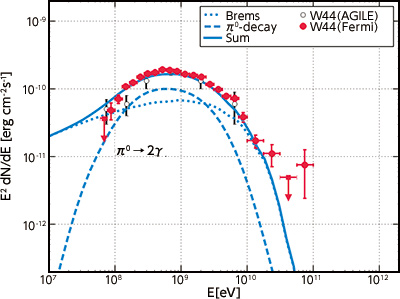TOP > Report & Column > The Forefront of Space Science > 2013 > Physics of Fermi Acceleration Explored by Fermi Gamma-ray Space Telescope
![]()

Direct evidence of high-energy proton We can approach the gamma-ray emission mechanism using X-ray observation results such as the case of Tycho's supernova remnant. A more direct approach is to identify the emission mechanism from the gamma-ray spectral shape. Because Fig. 3 shows an example of a gamma-ray spectrum. The intensity of gamma-ray emission rapidly drops under several hundred Mega eV, which is the spectral shape peculiar to 
Not limited to supernova remnants, the phenomenon of high-energy particle acceleration in celestial bodies has been observed through high-energy electrons. We believe that our achievement is significant in astrophysics because the observation of high-energy protons became possible for the first time. Expectations for ASTRO-H Although I have mainly discussed our research on gamma-ray observation above, X-ray observation also plays an important role in the research of particle acceleration in shock waves. Japan leads the development of the next-generation X-ray astronomical satellite, ASTRO-H, in which the author also participates as a team member. The X-ray micro-calorimeter to be installed on ASTRO-H will be a so-called nondispersive spectrometer. This enables ultra-high resolution X-ray spectral analysis, which has previously been impossible to apply to spatially-extended celestial objects such as supernova remnants. It is expected that new achievements including measurement of ion temperature and turbulence and/or discovery of deviation from Maxwell distribution could be attained through X-ray diagnosis of thermal plasma. The launch of the ASTRO-H is planned for 2015. The satellite should bring many breakthroughs in various fields, not limited to supernova remnants. (Yasunobu Uchiyama)
|
||||||




